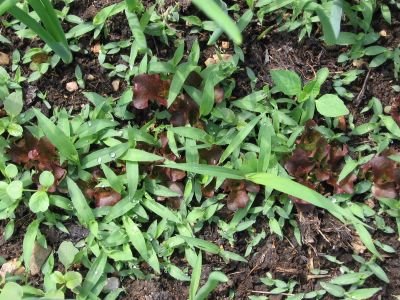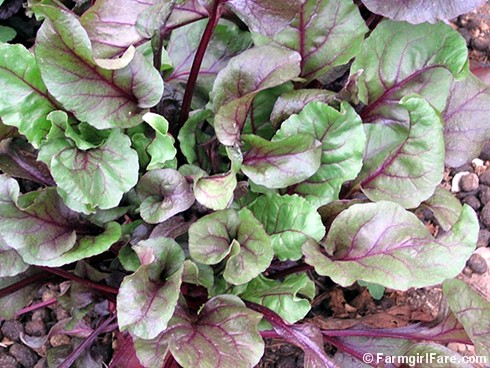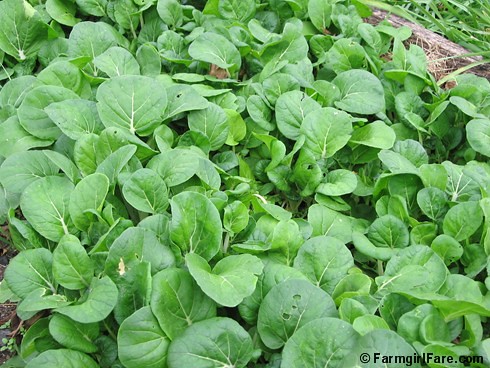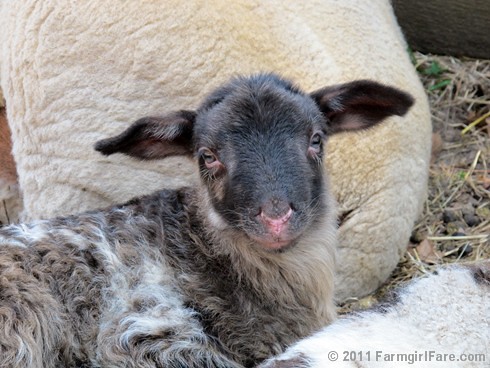
Bull's blood beet seedlings between onion rows
Realization Of The Day:
My experimental companion planting in the onion plot is, so far, a semi-success.
Back on April 1st, I planted five rows of onion sets in one of my 4' x 8' raised beds. Between the onion rows, I sowed three kinds of beet seeds and two kinds of lettuce seeds. Usually I simply mulch the entire plot with grass clippings once the onions have poked up.
The idea behind this experiment was that the companion plantings would create shade that would keep weeds from growing between the rows. They would also provide crops in otherwise unused space. (Click here to read the original onion planting post.)
Great in theory, but not so great in reality. I think part of this was my fault, though. Okay, the Bull's Blood beet seedlings have come up nicely, and, as you can see in the above photo, they are doing a good job at blocking out the weeds. I think if I mulch around them and the onions with grass clippings right now, we should be able to stay weed free until harvest.

Detroit beet seedlings in the same row as the bull's blood seedlings
However, further down the row we come to the Detroit beets. The leaves on these seedlings are smaller and the planting is slightly thinner. Thick, nasty grass has sprouted up all over. These are tough little weeds that are not easy to pull up without disturbing the adjacent beets and delicate, shallow onions. And they are so close to the ground it is hard to snip them at the base (which can work very well with some types of weeds). I'll do what I can and then mulch with grass clippings.

Dark Lolla Rossa lettuce strangled by weeds
Next we come to the row of Dark Lolla Rossa lettuce, and it is definitely a troubling sight. As you can see, the tiny lettuce seedlings are being obliterated by the same nasty grass. This is what I was afraid of. I'm not sure there is hope for this lettuce.
If I simply leave the weeds in place, I think they will end up completely covering the lettuce and blocking it from the sun. Although, now that I think about it, that might be good since it warming up, and the lettuce needs to stay cool. I have a feeling, though, that it would just turn into a big mess--plus the weeds have surrounded the onions as well, and that is not good.
I may end up having to hoe up this entire row and feed it to the chickens (nothing goes to waste around here!), but I am still not thoroughly convinced that this was a lousy plan. I have two ideas. The first is to sow lettuce seeds over the entire space between the onions rather than in a row, leaving empty soil on either side. Then it would look more like this practically weedless lettuce bed. I'm actually surprised I didn't do this in the first place. The second is to try a different variety of lettuce--something taller and less compact.
Overall, this has been an interesting experiment so far. One of the rows between the onions is now planted with garlic (in the hopes that I will be harvesting some late spring green garlic) because the lettuce seeds I sowed there did a no-show. I simply hoed the whole space up and started over. (What kind of hoe did I use to do this delicate work? My beloved scuffle hoe!)
I'll also be mulching that entire row (before the garlic even sprouts) with grass clippings. So already there are some new turns in the plan. And we certainly aren't finished yet. It will be interesting to see what transpires in this plot as the weeks go by.
Note: I'm embarrassed to admit this, but after looking at these photos, I think I may have the beet varieties backwards. My notes say otherwise, but it seems like the Bull's Blood would be the ones with the more reddish leaves, since they turn quite purple eventually. I also remember getting a bit turned around when reading my original planting notes (I have a little trouble with north, south, etc.). And here I thought this garden blog would solve all my record keeping problems!
© FarmgirlFare.com














